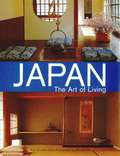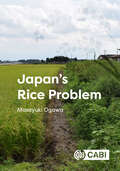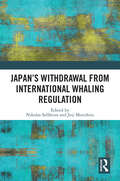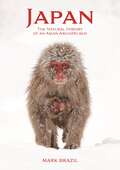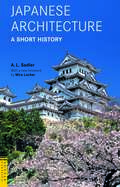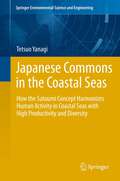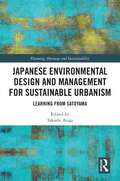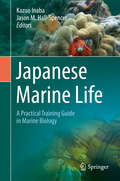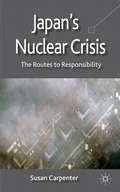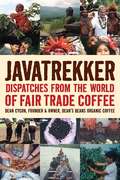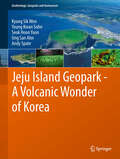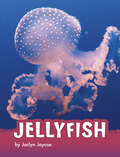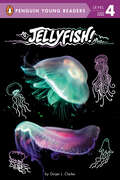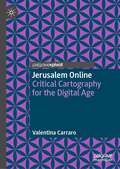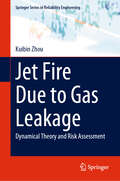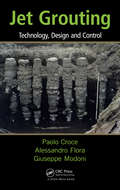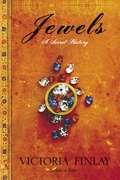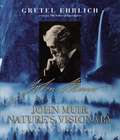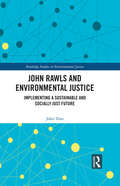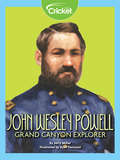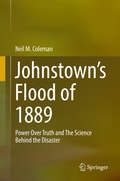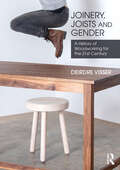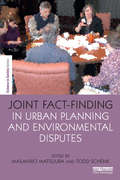- Table View
- List View
Japan the Art of Living
by Amy Slyvester Katoh Shin KimuraIn more than 300 beautiful photographs of the homes of both Westerners and Japanese, this book presents the art of living with Japanese style, offering exciting new ideas and inspiration for all. Exquisite homes in the Tokyo area, focusing on original and attractive use of Japanese antiques and folk crafts, are showcased. Also included is the latest information on antique markets and hints for where to see the art of living - in galleries, textile and craft shops, and resaurants.
Japan's Rice Problem
by Masayuki OgawaIn recent years there has been much debate in Japan over rice, which is considered the "staple food" of the Japanese people. Certain agricultural policies and traditional attitudes, the aging of farming communities and the lack of successors have become major problems, leading to the overproduction of rice and falling prices. Agricultural policy has been forced to respond to these problems. This book summarizes the changing relationship between the Japanese people and rice over the past half century, pointing out four turning points. The book then discusses in detail the "rice paddy glut" as the most recent rice problem in Japan. The book also points out that a "fifth tipping point " will come in the near future, when there will be an excess of farmland, and suggests ways to deal with this problem. Similar problems could be on the horizon in the future for developing countries that have invested heavily in increasing rice production.
Japan's Withdrawal from International Whaling Regulation
by Nikolas Sellheim Joji MorishitaThis book examines the impact and implications of Japan's withdrawal from the International Convention for the Regulation of Whaling (ICRW), which came into effect in July 2019. In 1982 the International Whaling Commission (IWC) adopted a moratorium on commercial whaling which has been in effect ever since, despite the resistance of some countries, first and foremost Japan, Norway and Iceland, that engage in commercial whaling. As one of the key contributors to scientific research and funding, Japan's withdrawal has the potential to have wide-ranging implications and this volume examines the impact of Japan's withdrawal on the IWC itself, on the governance of whaling, and on indigenous and coastal whaling. It provides backgrounds and commentaries on this decision as well as normative and legal discussions on matters relating to sustainable use of resources, and philosophies surrounding whaling in different IWC countries. The consideration of other international environmental regimes, such as the Convention on International Trade in Endangered Species (CITES) are also examined in order to determine the international ripple effect of Japan’s decision. The book reveals that this is not just a matter of whaling but one which has significant legal, managerial and cultural implications. Drawing on deep analyses of IWC structures, the book addresses core philosophies underlying the whaling debate and in how far these may influence environmental governance in the future. This book will be of great interest to students and scholars of environmental law and governance, biodiversity conservation and sustainable development, as well as policymakers involved in international environmental and conservation agreements.
Japan's Withdrawal from International Whaling Regulation (Routledge Studies in Conservation and the Environment)
by Nikolas Sellheim Joji MorishitaThis book examines the impact and implications of Japan’s withdrawal from the International Convention for the Regulation of Whaling (ICRW), which came into effect in July 2019. In 1982 the International Whaling Commission (IWC) adopted a moratorium on commercial whaling which has been in effect ever since, despite the resistance of some countries, first and foremost Japan, Norway and Iceland, that engage in commercial whaling. As one of the key contributors to scientific research and funding, Japan’s withdrawal has the potential to have wide-ranging implications and this volume examines the impact of Japan’s withdrawal on the IWC itself, on the governance of whaling, and on indigenous and coastal whaling. It provides backgrounds and commentaries on this decision as well as normative and legal discussions on matters relating to sustainable use of resources, and philosophies surrounding whaling in different IWC countries. The consideration of other international environmental regimes, such as the Convention on International Trade in Endangered Species of Wild Fauna and Flora (CITES), is also examined in order to determine the international ripple effect of Japan’s decision. The book reveals that this is not just a matter of whaling but one which has significant legal, managerial and cultural implications. Drawing on deep analyses of IWC structures, the book addresses core philosophies underlying the whaling debate and in how far these may influence environmental governance in the future. This book will be of great interest to students and scholars of environmental law and governance, biodiversity conservation and sustainable development, as well as policymakers involved in international environmental and conservation agreements.
Japan: The Natural History of an Asian Archipelago (Wildlife Explorer Guides #18)
by Mark BrazilA comprehensive, richly illustrated guide to Japan’s astonishing animals and plants—and the natural forces that have shaped themThis richly illustrated guide is the first comprehensive and accessible introduction to the extraordinary natural history of the Japanese archipelago. It explains how Japan’s geology, geography, climate, seas and currents have forged conditions supporting a diverse range of species—from cranes, bears, eagles and monkeys to plants, butterflies, dragonflies, frogs and snakes—many of which are found nowhere else in the world. Engaging and authoritative, this book is a must-have for anyone who wants to explore or learn about Japan’s natural wonders, from the Japanese Macaque—the famous snow monkeys—to the magnificent Steller’s Eagle.Features more than 878 colour photographs, illustrations and mapsProvides a lavishly illustrated introduction to many of Japan’s common and iconic mammals and birdsTakes readers on a naturalist’s journey to the key areas of Hokkaido, Honshu, Kyushu, Shikoku and Nansei Shoto, as well as the Izu, Ogasawara and Iwo islandsIntroduces Japan’s geology, geography, topography, climate, habitats, biodiversity and much moreExplains where and how to watch and photograph wildlife in Japan, including whales
Japanese Architecture: A Short History
by A. L. Sadler Mira LocherA. L. Sadler's invaluable study of Japanese architecture first appeared in 1941. Considered a classic in its field, unequaled in clarity and insight, Japanese Architecture A Short History is a lucid and uncomplicated introduction to this important aspect of Japanese culture. Beginning with the earliest evidences from prehistory and ending with the Edo period, when Japan attained stature as a modern state, Japanese Architecture is as relevant today as it was in 1941.
Japanese Commons in the Coastal Seas
by Tetsuo YanagiThe author proposed the satoumi concept, analogous to the satoyama concept on land, as "coastal sea with high biodiversity and productivity in harmony with human interaction" in 1998. The concept for environmental conservation in the coastal seas has been widely accepted and was included in the Japanese national policy of "Strategy for Establishment of an Environmental Nation" in 2007. This book is a translation of the author's Japanese book (2010) in response to concerns and questions about satoumi, including: Does biodiversity increase as a result of human interaction in coastal seas? Do the economics of fishing villages need to be considered in detail? What legal support is necessary for the creation of satoumi? Is there a relation between the concepts of God and Nature in satoumi? What is the relationship between fishermen and city dwellers? Chapter 1 presents the basic concept of satoumi. In Chapter 2 the relation between biodiversity and human interaction, economic problems related to satoumi, legal support for satoumi creation, satoumi from the point of view of landscape ecology, and the relation between society and science with regard to the satoumi movement are discussed. In Chapter 3 examples of satoumi creation in Japan are presented, and in Chapter 4 the overseas dissemination of the satoumi concept is introduced, with Chapter 5 providing the conclusion. Chapter 1 presents the basic concept of satoumi. In Chapter 2 the relation between biodiversity and human interaction, economic problems related to satoumi, legal support for satoumi creation, satoumi from the point of view of landscape ecology, and the relation between society and science with regard to the satoumi movement are discussed. In Chapter 3 examples of satoumi creation in Japan are presented, and in Chapter 4 the overseas dissemination of the satoumi concept is introduced, with Chapter 5 providing the conclusion.
Japanese Environmental Design and Management for Sustainable Urbanism: Learning from Satoyama (Planning, Heritage and Sustainability)
by Takashi ArigaThis book responds to the need to rehabilitate the holistic urban environment by introducing planning approaches which focus on the Japanese idea of “Satoyama.”“Sustainable development” has become a prime concern of planning, and society is expending great efforts to achieving this end. Appreciation of cities’ environmental assets has become more widely accepted and deeply taken to heart—not only by specialists, but also by citizens and communities. The balance between human settlements and the natural environment has changed. This has posed an environmental issue in that urban settlements engulf the greenbelts and water networks that help sustain the urban natural environment. Given these issues, we must consider a morphology toward creating a more sustainable urban system that regenerates the relationship between human settlements, utilizing the architectural resources within our urban fabric and its interaction with the surrounding natural environments. This book is a guide to the theory, methodologies and practical applications of environmental design and city and regional planning of regenerative systems toward sustainable urbanism. This book also explores the socio-cultural and economic implications of sustainable urbanism and examines urban forms, land use patterns and their built-up environments that can result from the applications.This book will appeal to a wide range of readers including researchers and students of architectural design, urban planning, heritage protection and sustainable development, but also professionals who are involved in improving the relationship of human settlements with natural resources.
Japanese Marine Life: A Practical Training Guide in Marine Biology
by Kazuo Inaba Jason M. Hall-SpencerThis book gives an overview of the diverse marine fauna and flora of Japan and includes practical guides for investigating the biology and ecology of marine organisms. Introducing marine training courses offered at a range of Japanese universities, this is the first English textbook intended for marine biology instructors and students in Japan. It provides essential information on experimental procedures for the major areas of marine biology, including cell and developmental biology, physiology, ecology and environmental sciences, and as such is a valuable resource for those in Asian countries that share a similar flora and fauna. It also appeals to visitors interested in attending Japanese marine courses from countries around the world.
Japan’s Nuclear Crisis
by Susan CarpenterAn analysis and exploration into the impact of Japan's 2011 nuclear crisis. Investigation of the disaster will pose questions regarding why Daiichi was constructed in an earthquake-prone zone and was still operating despite problems that had been plaguing the reactors since 1989 such as cracks in infrastructure and leaks in radioactivity.
Javatrekker: Dispatches from the World of Fair Trade Coffee
by Dean CyconIn each cup of coffee we drink the major issues of the twenty-first century-globalization, immigration, women's rights, pollution, indigenous rights, and self-determination-are played out in villages and remote areas around the world. In "Javatrekker: Dispatches from the World of Fair Trade Coffee," a unique hybrid of Fair Trade business, adventure travel, and cultural anthropology, author Dean Cycon brings readers face-to-face with the real people who make our morning coffee ritual possible. Second only to oil in terms of its value, the coffee trade is complex with several levels of middlemen removing the 28 million growers in fifty distant countries far from your morning cup. And, according to Cycon, 99 percent of the people involved in the coffee economy have never been to a coffee village. Cycon changes that in this compelling book, taking the reader on a tour of ten countries in nine chapters through his passionate eye and unique perspective. Cycon, who is himself an amalgam-equal parts entrepreneur, activist, and mischievous explorer-has traveled extensively throughout the world's tropical coffeelands, and shows readers places and people that few if any outsiders have ever seen. Cycon introduces us to the Mamos of Colombia-holy men who believe they are literally holding the world together-despite the severe effects of climate change caused by us, their "younger brothers. " He takes us on a trip through an ancient forest in Ethiopia where many believe that coffee was first discovered 1,500 years ago by the goatherd Kaldi and his animals.
Jeju Island Geopark - A Volcanic Wonder of Korea
by Andy Spate Kyung Sik Woo Seok Hoon Yoon Ung San Ahn Young Kwan SohnThis book will deal with geological as well as cultural, historical, archaeological and biological aspects in Jeju Global Geopark. It will start with introduction of Jeju Global Geopark, geographic setting, habitats, history, economy and tourism, management, general geology and geosites, future geosites, other significant heritage sites, economically sustainable tourism, education and promotion and management plan.
Jellyfish (Animals)
by Jaclyn JaycoxDid you know jellyfish aren’t really fish? These invertebrates have been around for millions of years. With easy-to-read facts and colorful photos, readers will enjoy discovering all the details about these interesting animals.
Jellyfish! (Penguin Young Readers, Level 4)
by Ginjer L. ClarkeLearn the fascinating story of one of the world's oldest animals: jellyfish!Jellyfish are everywhere and are one of the Earth's most fascinating animals. From the giant Nomura jellyfish in Japan, to the small but deadly kingslayer jellyfish in Australia, veteran nonfiction author Ginjer L. Clarke spotlights one of the world's oldest animal groups. Told with simple language and shown with vivid photographs, Jellyfish! is perfect for emerging readers curious about the natural world.
Jerusalem Online: Critical Cartography for the Digital Age (The Contemporary City)
by Valentina CarraroThe book addresses the rapid shifts which have taken place within cartography, and argues that no amount of technological sophistication will lead to neutral representations, and that as such critical cartography provides a solid foundation for questioning the power of maps. It considers the fragmentation, dynamism and opacity that characterise online maps, and argues for the need of new ways of thinking and researching maps. The book offers an approach grounded in ‘ontological’ social theory and feminist technoscience, and illustrates it through the analysis of three Jerusalem-related mapping controversies. Using online media, historical maps and ethnographic work, each case study explores a different map provider and a recent mapping development: Google Maps and the distributed authorship of web-maps; Waze and algorithmic navigation; OpenStreetMap and crowdsourcing. The book is a key read to faculty and advanced students in Urban Studies and Critical Cartography. It will particularly appeal to those working in the digital geographies
Jet Fire Due to Gas Leakage: Dynamical Theory and Risk Assessment (Springer Series in Reliability Engineering)
by Kuibin ZhouThis book presents a theoretical framework for the quantitative calculation of casualties and damage from jet fires caused by high-pressure gas leaks in pressure vessels or pipelines. The framework incorporates gas leakage models, combustion dynamics models, thermal radiation models, and thermal damage criteria. It conducts sensitivity and uncertainty analyses for the input parameters of the theoretical framework. The robustness of the theoretical framework is verified through field tests. Ultimately, the theoretical framework is used to quantitatively analyze the accidents involving jet fires due to the rupture of natural gas transmission pipelines. The sub-models within the theoretical framework are developed using the fundamental principles of thermodynamics, combustion, fluid dynamics, and heat transfer, and have been validated by small-scale laboratory tests. However, the theoretical framework receives the validation of field tests and real-world case studies. The theoretical deductions in this book offer significant guidance for scaling up from the laboratory experiments to field applications. The book is intended for anyone interested in understanding the risks associated with gas leaks and jet fires. The methodology enables the calculation of hazards for specific processes in isolation or their integration to assess overall consequences.
Jet Grouting: Technology, Design and Control
by Alessandro Flora Paolo Croce Giuseppe ModoniUnlike similar titles providing general information on ground improvement, Jet Grouting: Technology, Design and Control is entirely devoted to the role of jet grouting - its methods and equipment, as well as its applications. It discusses the possible effects of jet grouting on different soils and examines common drawbacks, failures and disadvantag
Jewels: A Secret History
by Victoria FinlayThroughout history the desire for jewels has made and destroyed individual, families and even empires. Today, despite our ability to manufacture synthetics, gemstones still hold their appeal. Victoria Finlay investigates why in her extraordinary journey to uncover the hidden world of precious stones. The starting point is a sapphire given to her by her parents that was harvested, not by a miner as she had imagined but by men in muddy loincloths trawling a warm stream in Sri Lanka. The extraordinary travels in JEWELS: A SECRET HISTORY take her cycling along the Baltic Amber Route, down the emerald mines of Afghanistan. As we learn from a ruby trader in Burma, the more precious a jewel, the greater the human cost of acquiring it, and JEWELS: A SECRET HISTORY also explores the human histories of gemstones. Along the way we learn from Victoria, a qualified gemologist, how to grade a pearl, what New Age 'crystal therapy' is about, and why one of the rarest sapphires in the world is orange. Victoria Finlay's unique blending of travelogue and narrative history ensures that this book, the first for the general reader, will be as unforgettable as the stones themselves.
John Muir
by Thomas LockerLaced with richly painted landscapes, this book brings readers the world and words of John Muir. This is the second book in a series of illustrated books by Thomas Locker that introduces readers to notable people who loved and wrote about the American land, especially about the value of wilderness.
John Muir: Nature's Visionary
by Gretel EhrlichIn this definitive photobiography, Ehrlich brings her award-winning grace and insight to the life of one of our nation's most prized environmental heroes--John Muir, a founder of the Sierra Club.
John Rawls and Environmental Justice: Implementing a Sustainable and Socially Just Future (Routledge Studies in Environmental Justice)
by John TönsUsing the principles of John Rawls’ theory of justice, this book offers an alternative political vision, one which describes a mode of governance that will enable communities to implement a sustainable and socially just future. Rawls described a theory of justice that not only describes the sort of society in which anyone would like to live but that any society can create a society based on just institutions. While philosophers have demonstrated that Rawls’s theory can provide a framework for the discussion of questions of environmental justice, the problem for many philosophical theories is that discussions of sustainable development open the need to address questions of ecological interdependence, historical inequality in past resource use and the recognition that we cannot afford to ignore the limitations of growth. These ideas do not fit in comfortably in standard discourse about theories of justice. In contrast, this book frames the discussion of global justice in terms of environmental sustainability. The author argues that these ideas can be used to develop a coherent political theory that reconciles cosmopolitan arguments and the non-cosmopolitan or nationalist arguments concerning social and environmental justice. This book will be of great interest to students and scholars of environmental philosophy and ethics, moral and political philosophy, global studies and sustainable development.
John Wesley Powell: Grand Canyon Explorer
by Jerry MillerJohn Wesley Powell was known for his explorations of the canyon land area of southern Utah and northern Arizona, still "unknown" in the 1860s.
Johnstown’s Flood of 1889: Power Over Truth and The Science Behind the Disaster
by Neil M. ColemanScience now reveals the true cause of the dam breach flood that destroyed Johnstown in 1889. The tragic loss of more than 2200 lives was preventable; the initial investigation of the flood was hijacked, delayed, and distorted by powerful members of the industrial elite. This book bridges the gap between history and science, reexamining eyewitness accounts of the flood and historic documents about the investigation, and applying new LiDAR, GPS, and hydraulic studies to solve the mystery – what caused the Great Flood of 1889? The book includes a notable chapter on the “sister” of the South Fork Dam, “The Forgotten Dam” at Hollidaysburg, PA.
Joinery, Joists and Gender: A History of Woodworking for the 21st Century
by Deirdre VisserJoinery, Joists and Gender: A History of Woodworking for the 21st Century is the first publication of its kind to survey the long and rich histories of women and gender non-conforming persons who work in wood. Written for craft practitioners, design students, and readers interested in the intersections of gender and labor history—with 200 full-color images, both historical and contemporary—this book provides an accessible and insightful entry into the histories, practices, and lived experiences of women and nonbinary makers in woodworking. In the first half the author presents a woodworking history primarily in Europe and the United States that highlights the practical and philosophical issues that have marked women’s participation in the field. Research focuses on a diverse range of practitioners from Lady Yun to Adina White. This is followed by sixteen in-depth profiles of contemporary woodworkers, all of whom identify fine woodworking as their principal vocation. Through studio visits, interviews, and photographs of space and process, the book uncovers the varied practices and contributions these diverse artisans make to the understanding of wood as a medium to engage spatial, material, aesthetic, and even existential challenges. Beautifully illustrated profiles include Wendy Maruyama, one of the first women to earn an MFA in woodworking in the US; Sarah Marriage, founder of Baltimore’s A Workshop of Our Own, a woodshop and educational space specifically for women and gender non-conforming makers; Yuri Kobayashi, whose sublime work blurs boundaries between the worlds of art and craft, sculpture, and furniture; and Folayemi Wilson, whose work draws equally on African American history and Afrofuturism to explore and illuminate the ways that furniture and wood traditions shape social relations.
Joint Fact-Finding in Urban Planning and Environmental Disputes (The Earthscan Science in Society Series)
by Masahiro Matsuura and Todd SchenkThe days of rationalist scientific management and deference to official data are behind us. The credibility of experts and the information they provide are regularly challenged; officials are routinely provided with conflicting sets of facts as they plan and make decisions; and decision makers and stakeholders alike are largely skeptical that technical information will adequately account for the various interests and concerns and lead to the right outcomes. They struggle to reconcile technical information with other forms of knowledge, and differing interests, priorities and perspectives. Issues like climate change are complicating matters even further, as scientists and technicians must increasingly acknowledge the uncertainty and potential fallibility of their findings, and highlight the dynamic nature of the systems they are explaining. This book examines how groups looking to plan and make decisions in any number of areas can wade through the imperfect and often contradictory information they have to make fair, efficient, wise and well-informed choices. It introduces an emerging and very promising approach called joint fact-finding (JFF). Rather than each stakeholder group marshaling the set of facts that best advance their respective interests and perspectives while discrediting the contradictory facts others provide, groups are challenged to collaboratively generate shared sets of facts that all parties accept. This book introduces readers to the theory of JFF, the value it can provide, and how they can adopt this approach in practice. It brings together writings from leading practitioners and scholars from around the world that are at the forefront of the JFF approach to science intensive policymaking, urban planning, and environmental dispute resolution. The first set of chapters outlines the concept of JFF, and situates it within other bodies of theory and practice. The second set of case-based chapters elucidates how JFF is being applied in practice. This book delivers a new perspective to scholars in the field of public policy, urban planning, environmental studies, and science and technology studies, as well as public officials, technical experts, policy consultants, and professional facilitators.
